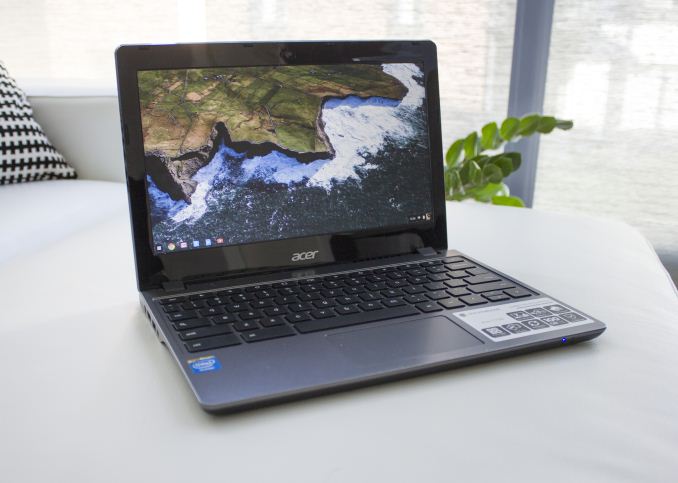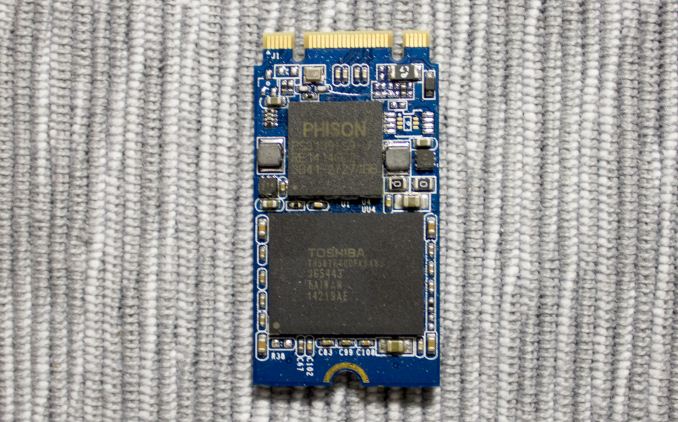Upgrading the SSD in Chromebook & MyDigitalSSD Super Boot Drive M.2 2242 SSD Review
by Kristian Vättö on October 21, 2014 8:00 AM EST
While the whole netbook boom kind of died with the introduction of tablets, Chromebooks have been gaining more and more traction recently. The original Windows netbooks failed to provide a smooth user experience due to the lack of operating system optimization, and Windows was simply way too heavy to be run with such limited resources. Chrome OS on the other hand was designed specifically for netbook-like devices. Google took a totally different approach by designing the Chrome OS around web and cloud-based services, which allowed the OS to be run with very little onboard storage.
Most of today's Chromebooks actually ship with either a small mSATA/M.2 SSD or have an eMMC package onboard, which is a bit ironic since Chromebooks are generally the cheapest laptops around, yet if you buy a Windows laptop that costs twice as much you will most likely end up with a traditional hard drive for storage. That is an enormous benefit that Chromebooks have because the lack of a hard drive enables much thinner and lighter designs, which translates into a better user experience.
The majority of the Chromebooks have 16GB of onboard storage with some high-end models having twice that. For the intended usage where everything is done in the web, that is sufficient, but when you need local storage for offline occasions (e.g. when traveling), 16GB or 32GB will not get you far. There is always the option of carrying external storage to expand the internal storage, but there is another alternative: upgrading the internal SSD.
For the purpose of this review, MyDigitalSSD sent us a 256GB Super Boot Drive in M.2 2242 form factor along with Acer's C720-2848 Chromebook.
| Acer C720-2848 Chromebook Specifications | |||||||||
| Display | 11.6" 1366x768 | ||||||||
| Processor | Intel Celeron 2955U (2/2, 1.4GHz, 2MB, 15W) | ||||||||
| Graphics | Intel HD Graphics (200MHz, 1GHz max Turbo) | ||||||||
| Memory | 2GB DDR3 | ||||||||
| Storage | 16GB SSD (M.2 2242) | ||||||||
| Connectivity | WiFi (802.11 a/b/g/n), Bluetooth 4.0, 1x USB 3.0, 1x USB 2.0, SD card reader, 1x HDMI | ||||||||
| Dimensions | 11.34" x 8.03" x 0.78" (W x D x H) | ||||||||
| Weight | 2.98lb | ||||||||
The C720 is what you would expect a Chromebook to be. The display is a bad TN panel, the trackpad does not always feel responsive, and the overall build is just plastic. It feels cheap, but the positive thing is that it really is cheap, as the C720-2848 currently retails for just $200. I cannot really give an objective review of the laptop itself as I have not used any other Chromebooks, but overall I am fairly impressed with what $200 gets you nowadays.
| MyDigitalSSD Super Boot Drive M.2 2242 Specifications | |||||||||
| Capacity | 8GB | 16GB | 32GB | 64GB | 128GB | 256GB | |||
| Controller | Phison S9 (PS3109) | ||||||||
| NAND | Toshiba A19nm MLC | ||||||||
| Sequential Read | Up to 545MB/s | ||||||||
| Sequential Write | Up to 410MB/s | ||||||||
| Warranty | Three years | ||||||||
Like other MyDigitalSSD's SSDs, the Super Boot Drive is based on a Phison controller and comes in a variety of capacities. The M.2 2242 currently tops out at 256GB since the form factor limits the number of NAND packages to two, and with 16GB die 128GB packages are the biggest that are available in the open market.
Notice that there is no DRAM at all. The M.2 2242 form factor lacks the space for a dedicated DRAM chip, so the NAND mapping table and host IO caching is done in the internal caches of the controller (usually a few megabytes of SRAM). There is a bit of a performance penalty from doing that as the internal caches are much smaller, but it is the only viable way to squeeze a full SSD into such small area.
Test Systems
There are two major items we want to look at in this review: first, we want to investigate the upgrade procedure for the Acer C720 Chromebook and examine Chrome OS performance, and second we're going to look at the MyDigitalSSD Super Boot Drive as a standard SSD and run our usual storage tests. For AnandTech Storage Benches, performance consistency, random and sequential performance, performance vs. transfer size and load power consumption we use the following system:
| CPU | Intel Core i5-2500K running at 3.3GHz (Turbo & EIST enabled) |
| Motherboard | ASRock Z68 Pro3 |
| Chipset | Intel Z68 |
| Chipset Drivers | Intel 9.1.1.1015 + Intel RST 10.2 |
| Memory | G.Skill RipjawsX DDR3-1600 4 x 8GB (9-9-9-24) |
| Video Card | Palit GeForce GTX 770 JetStream 2GB GDDR5 (1150MHz core clock; 3505MHz GDDR5 effective) |
| Video Drivers | NVIDIA GeForce 332.21 WHQL |
| Desktop Resolution | 1920 x 1080 |
| OS | Windows 7 x64 |
Thanks to G.Skill for the RipjawsX 32GB DDR3 DRAM kit
For slumber power testing we used a different system:
| CPU | Intel Core i7-4770K running at 3.3GHz (Turbo & EIST enabled, C-states disabled) |
| Motherboard | ASUS Z87 Deluxe (BIOS 1707) |
| Chipset | Intel Z87 |
| Chipset Drivers | Intel 9.4.0.1026 + Intel RST 12.9 |
| Memory | Corsair Vengeance DDR3-1866 2x8GB (9-10-9-27 2T) |
| Graphics | Intel HD Graphics 4600 |
| Graphics Drivers | 15.33.8.64.3345 |
| Desktop Resolution | 1920 x 1080 |
| OS | Windows 7 x64 |
- Thanks to Intel for the Core i7-4770K CPU
- Thanks to ASUS for the Z87 Deluxe motherboard
- Thanks to Corsair for the Vengeance 16GB DDR3-1866 DRAM kit, RM750 power supply, Hydro H60 CPU cooler and Carbide 330R case












67 Comments
View All Comments
sligett - Wednesday, October 22, 2014 - link
But one might instead say --I have zero clue why Windows laptops are so popular. I tried one and it was laughably complex compared to Chromebooks that are now pretty much priced the same. This might be ok, but for its complexity, Windows doesn't really run any faster than its Chrome OS counterparts, nor does it get much better battery life at all. I just see no reason unless you just absolutely detest ChromeOS.
BrokenCrayons - Tuesday, October 28, 2014 - link
I think one of the root causes for Chrome OS drawing ire is Google's invasive data mining activities associated with the device, storage of information on their servers, and the linking of that data with web browsing habits (including sites that use Google Ad Services -- of which there are many), GPS and cellular triangulation information (if you also happen to be using Android), mail, app use, time spent in each app, and so forth. Google being behind Chrome is one of the biggest problems with uptake of the platform. Since most of Google's services are offered free of charge, you can be assured that they're generating profit by "farming" their users in the same way social networking does, by monitoring and analysing everything at all times on as many platforms as possible.patel21 - Wednesday, October 22, 2014 - link
If we can create a recovery media, then can we install it on normal PC's ?Bob Todd - Wednesday, October 22, 2014 - link
If you just want to play around and test it, you can just grab a Chromium OS build from various places.daddacool - Wednesday, October 22, 2014 - link
"While the whole netbook boom kind of died with the introduction of tablets"I remember the actual reason for the demise of netbooks being feature creep, obviously coupled with the associated price creep. Netbooks we're orginally known as SCCs; Small Cheap Computers. Once the price began edging up into budget laptop price, the case for them became much less compelling.
waldojim42 - Thursday, October 23, 2014 - link
Yep, I thought this too. I remember netbooks reaching into the $400~$500 range while still running crap Atom processors. I don't know who they expected would be in the market for them, but it sure wasn't me.a1exh - Wednesday, October 22, 2014 - link
How well does the "chrome://imageburner" upgrade method work? If your internal 16/32GB drive is almost full (of non-compressible data) presumably you need a 16/32GB SDHC or USB stick?extide - Friday, October 24, 2014 - link
It doesnt back up your daownloaded data, just the OS.abianand - Thursday, October 23, 2014 - link
Does this SSD upgrade keep the cost of this Chromebook at $200 or increase it?Suo.Eno - Thursday, October 23, 2014 - link
Here you go brohttp://www.anandtech.com/show/8543/upgrading-the-s...